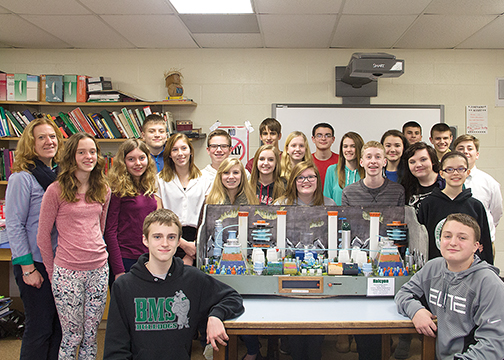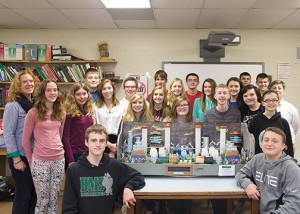

Sun staff
Imagination and ingenuity are prevalent in the project that took a class of eighth grade students to Washington D.C. to compete in a national competition.
Batavia Middle School’s 8th grade gifted language art class took their Future City project to D.C. Feb. 14-18 after winning the DiscoverE’s Future City Competition Ohio region in Columbus on Jan. 17 against 18 schools.
The students won the best use of innovate construction materials and technique, one of 20 special awards given out at nationals, Language Arts Teacher Mary Bradburn said. Forty-six teams competed for awards.
“They did really well,” Bradburn said.
The Future City Competition is a national competition for students in sixth, seventh and eighth grade. The students work with an engineer mentor to create and build a city of the future with solutions to an engineering problem, according to the website.
“I’m happy and relieved at the same time. I’m happy we got to come to Washington and I’m relieved the stress is finally over,” student Jett Young said. This is the first year the group from Batavia won a special award.
The class also won third in the region for the two essays the students submitted, Bradburn said. She has been this class’s teacher for the past four years.
This is Bradburn’s ninth year of having her student participate in the competition and the second year in a row her class has won regional.
Most of the project, which includes making a model, writing an essay and writing and practicing a public speaking component, is done on the students’ and Bradburn’s own time, she said. She does work on the project with the students most Fridays from October until February.
The 2015 theme is Feeding Future Cities. It challenges students to find ways to grow crops within their cities, according to the website.
The students created a city called Halcyon, which they located in Iceland in the year 2242. Locating the city in Iceland made their project more of a challenge, an attempt get the judges’ attention, student Cole Taylor said.
In the skit three speakers from the class present to judges, death comes to wipe out Halcyon and its inhabitants but the mayor and the head engineer strike down each of death’s ideas by showing how well Halcyon is designed.
The speakers told presenters about the city’s medical technologies, their method of emergency communication, how the city uses geothermal energy, the waste water system, the city’s engineering and design process, a lava levee to prevent lava from hitting the city and more.
Each city needed a vegetable and a protein, said Mady Flandermeyer, one of the speakers. The vegetable is creet, a cross between a carrot and a beet that the students created.
The protein is moringa, which provides daily carbohydrates, protein, antioxidants, nutrients, fat and fiber all in one leaf, said Jett Young, one of the speakers.
The students probably worked on the model for 75-80 hours and the speakers spent 75-80 hours getting their presentation ready, Bradburn said.
The students have a $100 budget to buy paint and any supplies, so the students used mostly recycled materials. The class gathered materials from their houses and were allowed to disassemble past models and use those materials, student Koby Pruitt said.
Being in Columbus was very fun, but very stressful for the whole class because everyone put so much work into it, said student Jordan Buelterman.
“It was like being on a roller coaster, you get this rush from it. It was so exciting to see all my friends excited as well and we knew that we had pulled it off and it was so much fun in the process,” said Flandermeyer.
Batavia also won best infrastructure, best moving part, best use of transportation and best innovative solutions for water and wastewater utilities to reduce costly reinvestment in America’s aging infrastructure, according to Future City’s website.
